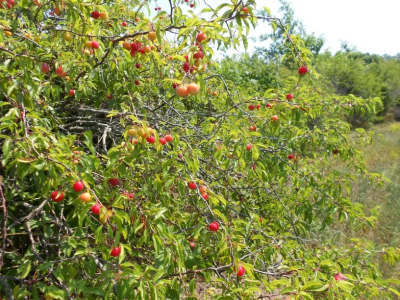
Prunus angustifolia, or Sandhill plum, is native to much of Kansas. It is the most common wild plum in western Kansas. They are found striving on sandy prairies, where they are very effective in stopping blowing sand. Sandhill plum is similar to the American plum, both forms thickets from roots suckers. There are other hybrid varieties of the American plum, such as Chickasaw plum, Shiro, or Santa Rosa plum.
Uses of Sand Hill plums range from cover for native bird species to making jams, jellies, and wine from the fruit. Found naturally in pastures, roadsides, and woodland borders, it has also been planted extensively throughout Kansas for its delicious fruit.
It is not easy to find these plums growing in the wild; pickers guard their secret spots. Use your fall and winter nature hikes to scout out precious Sand Hill plums for next year’s harvest. If you are not interested in picking your own plums, fruit sellers and farmers from Central and Westers Kansas arrive at our local KC area markets to sell the precious plums or already made jam and jellies.
Sand Hill Plum Jam
What is the difference between plum jelly and preserves? The biggest difference between jelly, jam, and preserves is how much of the original fruit is used to make them. Jelly has the smoothest consistency and is made by crushing a fruit and discarding the solid chunky leftovers creating a gelatinous spread. Jam is similarly made by crushing a fruit but leaves in most of the solid pieces of the fruit’s fibers and seeds to give it a spreadable consistency. Preserves use most of the fruit and are simply chopped into smaller pieces of fruit. There is also Marmalade, which is a fruit preserve made from the juice and peel of citrus. The well-known version is made from bitter orange, but it is also made from lemons, limes, grapefruits, mandarins, sweet oranges, and bergamots.
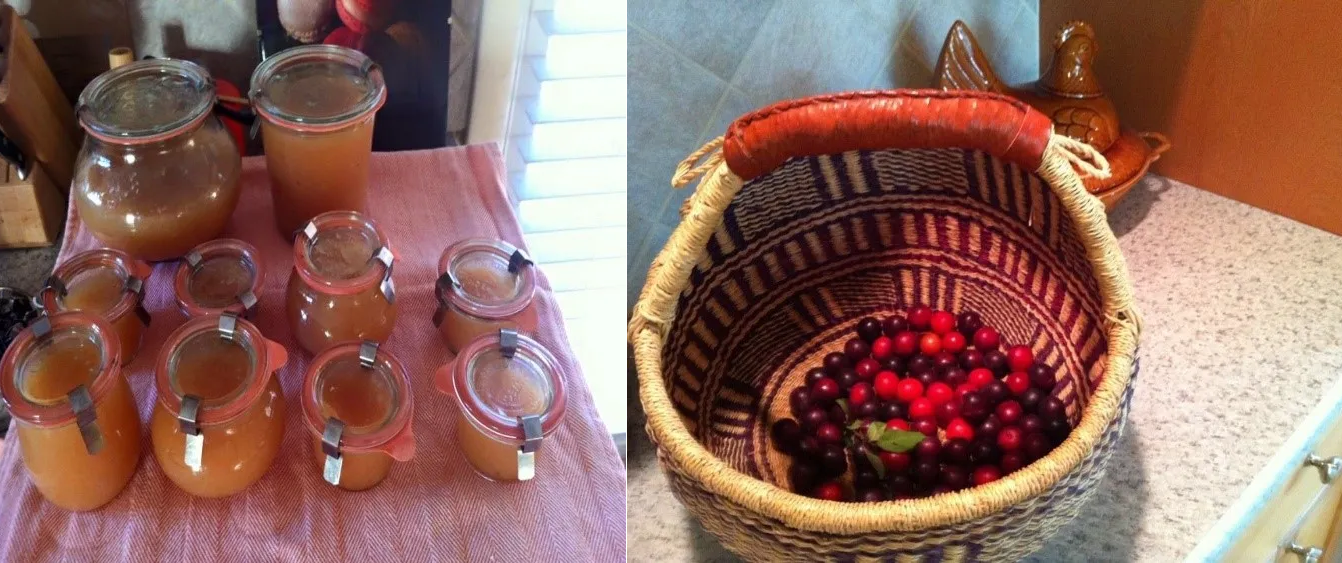
Pectin:
Four Components ensure that a jam will set up: fruit, pectin, sugar, and acid. Pectin, a substance that thickens jams, naturally occurs in citrus fruits and apples, particularly in their skins and cores (not found in strawberries and stone fruit like peaches).
Setting Point:
This is an important step in the jam or jelly-making process. To test if your jam or jelly has reached the setting point, drop a teaspoonful onto a cold saucer (from the freezer cold). Leave for 1 minute, then push the jam or jelly with the tip of the finger. If it wrinkles, it’s ready to pour into jars. If not, continue to cook and test every couple of minutes.
Sterilizing jars before canning:
It’s important to sterilize the jars and bottles that you use for storing your jams or jellies. Anything that contaminates your food inside will cause it to spoil quickly. They could be sterilized in the oven or the dishwasher. I sterilize mine in a large shallow pan with water with jars sitting upside down in the pan. The steam gets inside of the jars, and I let them scald for 10 minutes.
Sand Hill Plum Jam
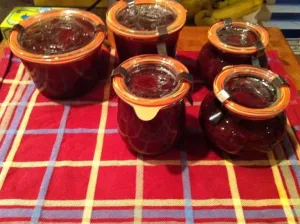
Magda Born
This is my favorite homemade jam. Although this doesn’t make a vast quantity of jam, the end result is so indulgent that a small teaspoon will instantly transport you to high summer. I enjoy mine spooned with a cup of yogurt. You can pick the unripe fruits and let them ripen in a single layer using a sheet pan to lay them on the counter. Depending on the tree, ripe plums will be anywhere from a bright red to a fuchsia-purple. They will get slightly squishy and have a sweet smell when they get ripe.I have different varieties from different canning projects depicted here. I also use European canning jars, which I like better, and I am used to working with them.
INGREDIENTS
- 6 c Sandhill plums
- 8 c White sugar
- 1 box Dry pectin please read instructions on the box
- 1 Tbsp Lemon juice
INSTRUCTIONS
1. De-stem and wash the plums. Put them in a large, heavy-bottomed pot and add an inch or so of water.
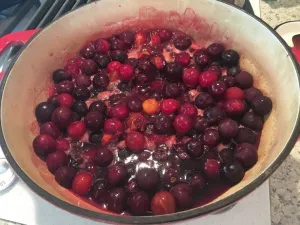
2. Once the plums start to heat up, they will break open and release the pulp and juice (as well as the pits). Cook that down, and enjoy the sweet/sour smell of the juice.
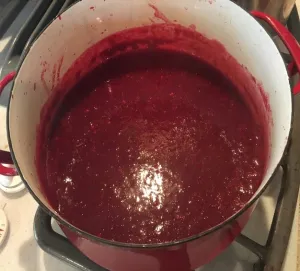
3. After they cook for a while (most of the plums have burst, and the skins start to shrivel a little), then you can let it start to cool. You can use a sieve and a few layers of cheesecloth to extract the fruit and press lightly on the pulp to get a little more juice out. (Some say pressing it down clouds the jam). Toss out the pulp and pits, or keep the pulp, as I do (to make it a real jam) and pick out only the pits.
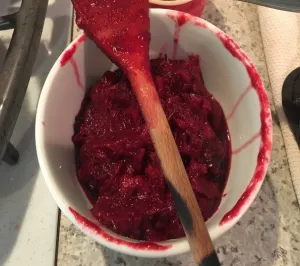
4. Return the fruit to the heavy-bottomed pot and heat the juice.
5. Add all sugar at once and stir with a whisk until dissolved. Make sure there are no clumps of sugar. Bring to a rolling boil, stirring constantly. This time, the rolling boil will make it seem like the mixture has doubled in volume, but that’s just because it’s boiling. This is a boil that can’t be “stirred down.” Keep stirring so that it doesn’t scorch!
6. Add pectin according to the instructions on the box. Remove from heat. Test for setting point as per instructions above.
7. Ladle into hot jars, leaving 1/2inch space from the rim of the jar. Wipe off rims and screw tops with a clean damp cloth. Top each jar with a warm lid, then twist on a band until tight. (I use European kind jars, which I am used to working with).
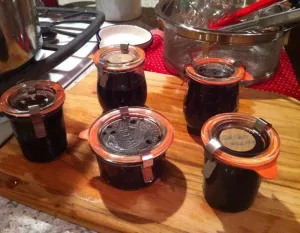
Processing the filled jars:
Place the jars in the pot filled with the rack and add enough water to cover by about 1 inch. (I use a large pasta pot that already has a basket. Bring water to a boil and process the jars for 10 minutes. Turn off the heat and leave the jars in the water for a few minutes. Remove the jars from the water and let cool completely, undisturbed, on a wire rack or a kitchen towel for 24 hours. The “ping” that you hear is the sound of the lid sealing to the jar. Some set the jars upside down to seal while cooling. If the jar does not seal properly, you should refrigerate it and use it within 3 weeks. Label the jars with the contents and date. Store the jars in a location that is moderately cool and fairly dark.
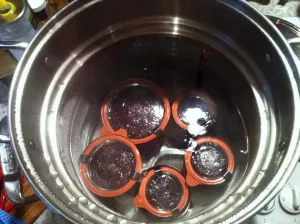
Library Resources:
The Modern Preserver: Jams, Pickles, Cordials, Compotes, and More by Kylee Newton.
Jam Session: A Fruit-Preserving Handbook by Joyce Goldstein; photographs by Ed Anderson
Contact me to talk about Sandhill Plums, home canning and pickling, or everything about farmers’ markets.
Magda Born
mborn@kckpl.org
Community Services Librarian
Kansas City, Kansas Public Library
625 Minnesota Ave.
Kansas City, KS 66101
913-295-8250 ext 1103